Hello All,
I am FAE of TaeHo Kim in TI Central regional KOREA.
My customer is Hansol tecnics which is developing the SMPS for LED TV.
The end user is Samsung VD in Korea.
They have got an EMI issue.
I send PCB pattern and LM3485 circuit.
Could you review the attached file?
If you find out some EMI problems from pattern or circuitm, reply to me by e-mail please.
Specification
Input DC voltage: 12.8V
Output SPEC: 5.3V/3.5A
Thank you.


